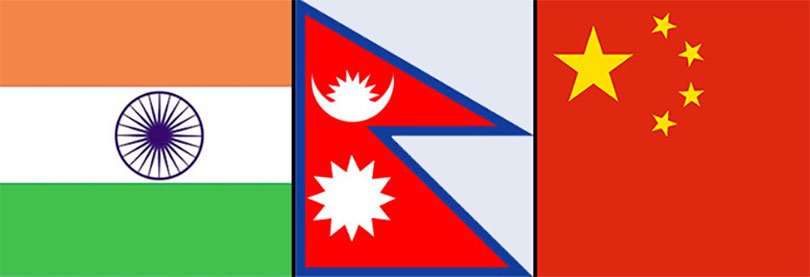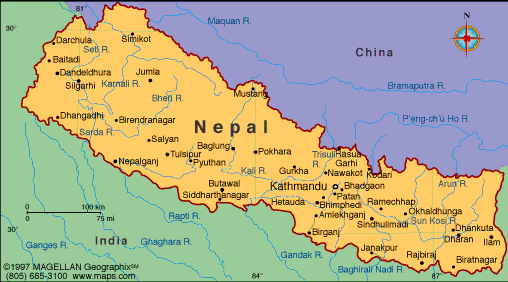Enemy at the gate
October 13, 2017 | Expert Insights

As China and Nepal continue to forge closer ties, there are growing concerns that this could directly impact the regional security of India.
Background
Nepal traces its roots back to ancient civilization. Its history began in the Kathmandu Valley in the Himalayas. The founder of Buddhism, Gautama Buddha, was born in Southern Nepal. The region is home to Mount Everest, the highest peak on Earth. The Gorkha Kingdom unified Nepal in the 18th century. Historians note that it was during this period that Nepal, as it currently exists, was formed. Later, the Kingdom of Nepal was established by the Shah Dynasty. It formed an alliance with the British Empire but the region was never colonized. Nepal for many centuries remained an isolated region that cut ties from the rest of the world. In Kathmandu the groups of Bahun, Chettri and Newari largely held the political power in the region. The people living in the Terai region include Tharus and Madheshis.
The ties between the modern states of India and Nepal was established when the two nations signed the Indo-Nepal Treaty of Peace and Friendship in 1950. Article 5 established that Nepal be free to import, from or through the territory of India, arms, ammunition or warlike material and equipment necessary for the security of Nepal. Article 6 provided national treatment to the citizens of the both nations and Article 7 established reciprocal basis, to the nationals of one country in the territories of the other the same privileges in the matter of residence, ownership of property, participation in trade and commerce, movement and other privileges of a similar nature.
This changed in the 20th century when Nepal began forging ties with regional neighbors, especially India. In 1951, Nepal adapted Parliamentary democracy. The royal kingdom would suspend this twice over the course of the century – once in 1960 and again in 2005. In 2008, the Nepali Hindu monarchy was formally ended after the Nepalese Civil War. At the time, the monarchy was the oldest Hindu monarchy in the world.
Nepal shares its borders with both India and China. Economically, India is its most important ally. India accounts for 60 per cent and 63 per cent, respectively, of Nepal’s imports and exports. The rest of the trade, valued at over $3 billion, is also routed through India.
Analysis

India and Nepal share close cultural ties. The people of both nations have a lot in common including the food, language and heritage. However, there is also a growing anti-Indian sentiment in Nepal. The region has openly begun questioning India’s interference in its domestic affairs.
Relations between India and Nepal have grown tense since 2015. Taking advantage of this, the Chinese influence in Nepal is at an upsurge and if ground reports are to be believed then over the past year or so, the Chinese have opened 32 border crossing points into Nepal. This poses a clear and present danger to India's national security interests. However, its current foreign policy initiatives are doing little to bridge the chasm in Indo-Nepal relations.
To understand the current geo-politics of Nepal more clearly, we need to understand not only the society but also the geography and political history of the country. Nepal, at a very broad level, can easily be divided into two parts - the plains and the mountains along the entire length of the country. There has always been an asymmetrical distribution of power between the residents of the hill and the Terai regions, with the hills always holding political sway
Historically, it has been the Bahun, Chettri and Newari groups in Kathmandu who have held political power and cultural hegemony over the national narrative of Nepal at the cost of the numerically significant yet politically marginalized ethnic groups in Nepal, mostly residing in the Terai region.
The people living in the Terai region are diverse in nature. The Tharus, the largest group of original settlers, are some 16 lakhs in number. Other hill castes who have been living here for several generations are around 60 lakhs. Those who are referred to as Madhesis number around 56 lakhs Tharus do not like to be called Madhesis, and those of hill origin are still identified as Pahadis. The Madhesis have castes and ethnicity similar to Bihar and eastern UP, with frequent intermarriages between families on either side of the border. The Madhesh has historically been part of the larger Mithila region and has close ties with India. Thus, many of the power centres in Nepal have spread the perception that most of the residents of Madhesh are in effect immigrants from Bihar rather than native Nepalis and retain their loyalties towards India.
The Madhesis led a large political movement in 2007 seeking the enlarged participation of the Terai in Nepal's politics and policymaking which resulted in the word "federalism" to be included in Nepal's interim constitution. The earthquake in April 2015, forced the Nepalese legislature to fast track the new constitution which reneged on the basic tenets of federalism as envisaged in the peace agreement in 2006 and the interim constitution. Thus, the ground was laid for another round of Madhesi agitation, which Kathmandu accused India of backing. The agitation began in September of 2015 and severely paralysed the Nepalese economy as well as society since Nepal depended heavily on India for all kinds of supplies.
Nepal accused India of imposing an unofficial five-month blockade at the border with Nepal over its concerns about the rights of the Madhesi people. The blockade prevented trucks carrying perishables like fruits and vegetables into Nepal. This led to an economic and a humanitarian crisis. India denied any role in the matter and stated that the supply shortages have been imposed by Madhesi protesters within Nepal. The hashtag #BackOffIndia also began trending on Twitter during this period.
This has provided the ideal gateway for China. The ties between Nepal and China were initially lukewarm. The trade ties have grown significantly since 1975. However, it was after 2015, that China aggressively began pursuing warmer relations with Nepal. In 2016, China opened 32 border-crossing points into Nepal. This could be a security concern for India.
The threat becomes more potent if China succeeds in replacing India as the key economic as well as security partner for Nepal. This would mean that China would have breached the Himalayan borders that separate India from the mainland.
The growing affinity between China and Nepal was further highlighted during the 2015 earthquake that devastated Kathmandu. China played a large role in the reconstruction efforts and India was conspicuous in its minimal presence.
In October 2017, two of the largest communist parties in Nepal announced a merger ahead of the national elections. This also sparked concern over whether the nation is inching closer to China. Details of the merger can be found here.
Assessment
Our assessment is that India’s strong cultural ties to Nepal are still its strength to hold onto soft power in the region. We believe that China has in recent months made significant inroads into both the political as well as the hearts and minds of the people of Nepal. We have to be worried about this growing sentiment, especially among the youth in Nepal. We further believe that China is capable of replacing India as the key economic and security partner for Nepal. This may not bode well for India, as it would mean that the Chinese will literally be at our gates and would have breached the Himalayan barrier that separates the two countries. The key question that we are asking is: Are we losing our battle for the hearts and minds of the Nepalese people?








Submitted by RN Ganesh (not verified) on Sat, 10/14/2017 - 07:20
While applauding your brief
While applauding your brief couched in nuanced and carefully considered terms, I think the answer to the closing question is a resounding "Yes". India,s response to its neighbours must not be based on transactional advantage. We have to have a magnanimous attitude, viewing each concession we make not as charitable act or a favour, but as an investment in our own security. We must bear in mind that nine of the Indian Army's finest battalions are from our valiant Gorkha regiment.
Submitted by synergia on Sat, 09/07/2019 - 12:58
Thank you for your insight
Thank you for your insight